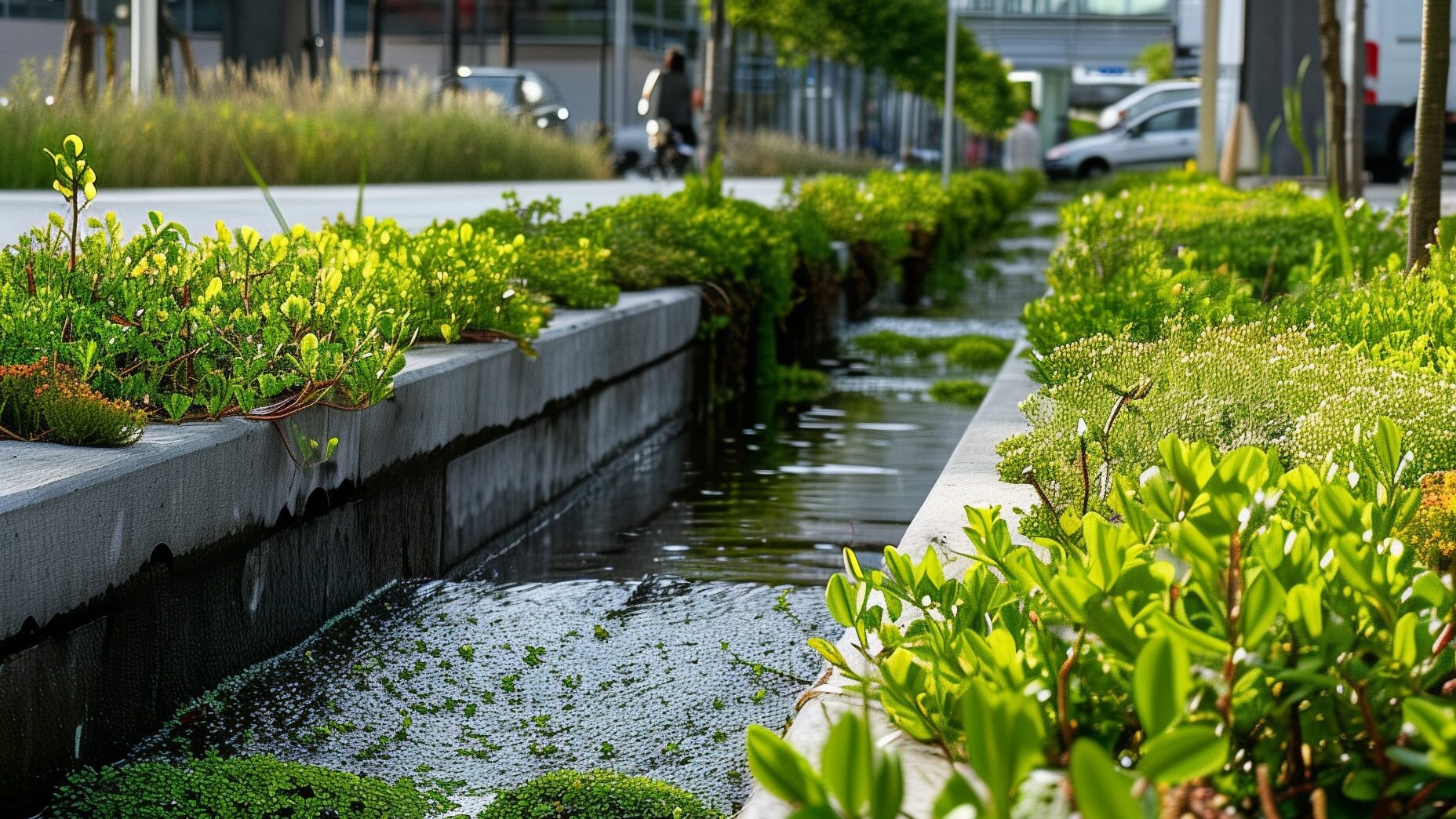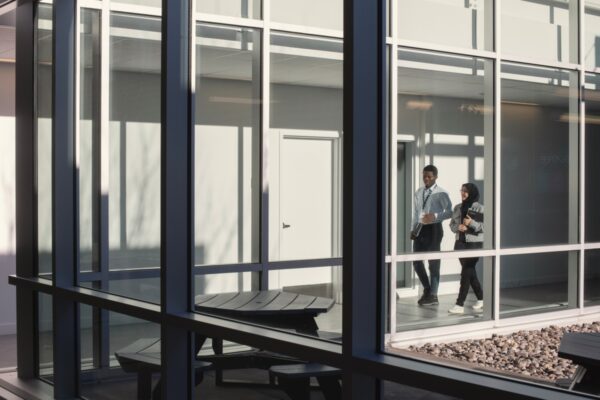- Overview
The series “A Quick Overview in Three Questions” highlights research in all its forms and offers an informed perspective on current issues.

Professor Sophie Duchesne specialist in hydrology and urban infrastructure
Québec is experiencing more and more episodes of torrential rain and severe thunderstorms during the summer season. While such events were rare just a few decades ago, they are becoming the new norm—a direct consequence of climate change.
Today’s urban infrastructure and city planning approaches were not designed to handle such extreme weather events. To cope with these downpours, municipalities must rethink the way they build—drawing on the new data and advances brought by scientific research, which is so instrumental to this process.
At the Institut national de la recherche scientifique (INRS), Professor Sophie Duchesne focuses her research on urban water management issues, including drinking water, stormwater, and wastewater. She is particularly interested in infrastructure renewal, the impact of heavy rainfall on water networks, and best practices for building more resilient cities.
Based at the INRS Eau Terre Environnement Research Centre, Sophie Duchesne leads the Hydraulic Management Laboratory for Drinking Water Distribution Networks and holds the Municipal Research Chair in Sustainable Water Management, supported by the Fédération québécoise des municipalités (FQM).
To better understand the water management challenges facing Québec municipalities, Professor Duchesne answers our questions.
To what extent are current urban water drainage systems no longer able to meet current needs in times of heavy rainfall?
Urban stormwater management systems, such as storm sewers, were designed based on historical rainfall data. However, due to climate change, we are already seeing shifts in rainfall patterns, and we know these changes will continue in the coming years. For example, an extreme rainfall event that used to occur only once every 10 years at the end of the 20th century could now happen twice as often. This means that sewer backups and surface flooding in urban areas will become increasingly frequent.

Au Québec, le dérèglement climatique cause non seulement une intensification des événements pluvieux extrêmes, mais également une hausse de la quantité de pluie totale tombée en une année ainsi qu’une augmentation des épisodes de pluie en périodes hivernale et printanière. Combinés à un sol gelé et à la fonte du couvert neigeux, ces événements peuvent aussi causer des dégâts importants en milieu urbain.
In Québec, climate disruption is not only intensifying extreme rainfall events but also increasing the total amount of annual rainfall and the frequency of rain in winter and spring. Combined with frozen ground and melting snow cover, these events can cause significant damage in urban areas.
In addition to climate change and the significant shifts in rainfall patterns it has caused, cities are often expanding faster and over larger areas than was anticipated when today’s stormwater systems were originally designed.
Urban development almost always goes hand in hand with an increase in hardened surfaces—from rooftops to roads, sidewalks, and parking lots. Unlike natural, permeable surfaces, these impermeable surfaces prevent water from infiltrating the ground. As a result, whenever it rains in the city, rainwater accumulates and flows over these surfaces, generating huge volumes of runoff that must be redirected to places where it will not disrupt human activities. The more a city grows and the more impermeable surfaces it has, the greater the volume of runoff—and the higher the risk of urban flooding.
The concepts of “sponge cities” and “sponge parks” are gaining attention. In your work, you study these solutions and have helped analyze these types of spaces. How do these concepts change the way we think about today’s cities?
The concept of a “sponge city”—which can also include the use of “sponge parks,” “sponge streets,” or “sponge parking lots”—is about transforming cities so that rainwater can make its way into the ground. That way, the city acts as a sponge that actually absorbs water rather than a vast impermeable surface that generates large volumes of runoff that need to be managed every time it rains. Of course, this doesn’t mean eliminating all concrete or asphalt, but rather redirecting runoff from these surfaces to areas where it can infiltrate. Traditionally, all runoff was channelled into underground pipes via storm drains. Now, the goal is to direct some of this water to permeable surfaces like gardens or planting beds.

Par exemple, dans le cas d’un parc éponge, les rues adjacentes au parc sont reprofilées afin que les eaux de ruissellement qui y sont générées lors d’une pluie soient dirigées vers le parc. Ce parc est pensé avec des aménagements particuliers qui favorisent la rétention temporaire de l’eau et son infiltration dans le sol, par exemple avec des petites digues pour retenir l’eau à des endroits où le sol est très perméable. Lors de pluies plus abondantes, les eaux excédentaires peuvent être relâchées vers le réseau souterrain de conduites, mais à un rythme beaucoup plus lent et en moins grande quantité que s’il n’y avait pas de parc éponge. En prime, lorsqu’il fait beau, les citoyens peuvent profiter du parc pour diverses activités sportives et récréatives, ou tout simplement pour relaxer !
For example, in a sponge park, adjacent streets are regraded so that rain runoff flows into the park. The park is designed with special features, such as small berms that hold water in areas with highly permeable soil, to promote temporary water retention and infiltration. In the event of heavier rainfall, excess water can still be directed to the underground sewer system—but at a much slower rate and in smaller volumes than would be possible without the sponge park. As a bonus, in good weather, residents can enjoy the park for sports, recreation, or simply relaxing!
The same principle applies to sponge streets and sponge parking lots. In these cases, vegetated areas are created along the edges or in the centre of the street or parking lot, where runoff from impermeable surfaces is directed. These areas are commonly known as bioretention systems. By carefully selecting plant species (perennials, shrubs, and trees) for these systems, we can not only retain and infiltrate stormwater but also promote evapotranspiration, or the process of returning water to the atmosphere. This further reduces the volume of stormwater entering the sewer system while helping cool urban neighbourhoods during the summer.
As a researcher, you actively support municipalities and government bodies in their efforts to adapt to climate change. What concrete benefits does this research offer residents?
We support communities by conducting research activities in collaboration with Québec municipalities and ministries and by sharing our findings with engineers, urban planners, and managers who can put them into practice. For nearly ten years, my team has conducted numerous research projects in collaboration with colleagues from Université Laval (G. Pelletier, G. Grégoire, and P. Lessard) and some fifteen Québec municipalities.
For example, we installed measuring instruments in multiple bioretention systems to better understand how these systems can help reduce the volume of stormwater discharged into sewer networks and improve water quality here in Québec. These studies revealed that bioretention systems perform very well in Québec’s climate—even in winter during thaw periods—contrary to what many had feared. We also carried out a project for the Ministry of Transport and Sustainable Mobility to evaluate the performance and benefits of permeable asphalt combined with a clear stone base as a stormwater management solution in a parking lot. The results of these studies allowed us to make recommendations for improving the design, construction, and maintenance of various types of sustainable urban stormwater management infrastructure, including vegetated systems.
More recently at INRS, we set up a Municipal Research Chair in Sustainable Water Management, supported by the Fédération québécoise des municipalités (FQM). One of the Chair’s goals is to pool resources and efforts across Québec’s municipal sector so that our research can address the most pressing needs of the greatest number of communities. It also aims to promote the dissemination of our findings to local users. Our work will focus not only on the stormwater management issues mentioned above, but also on drinking water supply challenges and the preservation of water resources and urban ecosystems.
By working directly with municipalities and ministries, we can ensure that our research findings are used to improve practices in the very short term—directly benefiting the residents of all Québec cities.



